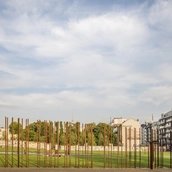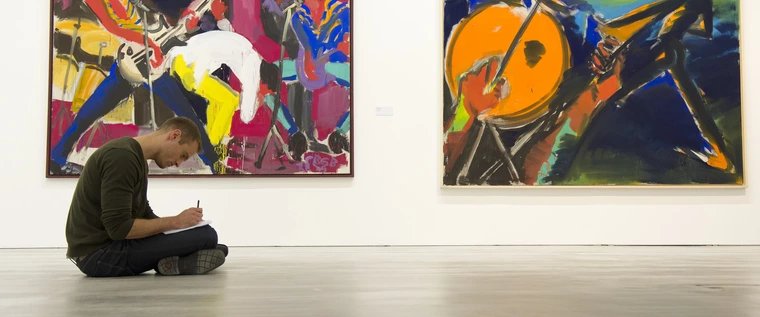
Exhibition at Belvedere
When "the reorganization of the world" and the division of Germany were decided upon at the Potsdam Conference in Cecilienhof Palace in 1945, this had a direct effect on the everyday life of many Potsdamers. This includes the people in the area around the Pfingstberg, which is now close to the border with West Berlin. The contemporary witness exhibition, which opened in 2020, gives people from the immediate vicinity of Pfingstberg a chance to have their say.
The residential and recreational area in the Nauen suburb, which until the end of the Second World War was characterized by villas and parks, is now being transformed into the Soviet "Military Town No. 7" with a prison of the Soviet secret service KGB and the headquarters of foreign espionage.nothing as before: everyday life at the Pfingstberg in Potsdam after 1945. Working, shopping and leisure activities of the residents are henceforth determined by this development. Procurement, for example, is done in the "Russenmagazin", a Soviet sales facility intended for members of the army and their families, but also open to GDR citizens. The allotment gardens on the slopes of the Pfingstberg became important private retreats and places of recreation during this period. Against this historical backdrop, the exhibition "Between Arbour and Russian Magazine" will be presented at the Belvedere Pfingstberg from 6 May 2020. Alltag am Potsdamer Pfingstberg 1945-1994" will be on display from 6 May 2020, giving contemporary witnesses from the immediate vicinity of the Pfingstberg a chance to speak. The already existing permanent exhibition on the history of the Pfingstberg ensemble in the Belvedere will be supplemented by a room on the ground floor of the West Tower. Here, visitors can learn about twelve multifaceted life stories of residents via three media stations. The contemporary witnesses Among them are the director, photographer and screenwriter Franz Baake, who lived in the Große Weinmeisterstrasse from 1941 to 1951 and experienced the invasion of Soviet troops into his residential area; Matthias Freydank, who spent his childhood and youth in the Villa Henkel, which was an old people's home during GDR times; and Mario and René Kade, who grew up in the Höhenstrasse and report on a carefree childhood in the 1980s. Some of these stories are sad and touching, but they are also funny and humorous and reflect the respective perception of the everyday life they experienced. Belvedere Pfingstberg, opening on 6 May at 2 p.m., free admission; meeting point: Entrance West Tower Belvedere Palace Exhibition from 7 May 2020 to 31 October daily 10-18 hrs, November/March Saturdays, Sundays and public holidays 10-16 hrs, castle entrance fee including exhibition: 6 € / reduced 4,50 € Supported with funds from the Federal Foundation for the Reappraisal of the SED Dictatorship. Supported with funds from the Ministry of Science, Research and Culture of the State of Brandenburg.When "the reorganization of the world" and the division of Germany were decided upon at the Potsdam Conference in Cecilienhof Palace in 1945, this had a direct effect on the everyday life of many Potsdamers. This includes the people in the area around the Pfingstberg, which is now close to the border with West Berlin. The residential and recreational area in the Nauen suburb, which until the end of the Second World War was characterized by villas and parks, is now being transformed into the Soviet "Military Town No. 7" with a prison of the Soviet secret service KGB and the headquarters of foreign espionage.nothing as before: everyday life at the Pfingstberg in Potsdam after 1945. Working, shopping and leisure activities of the residents are henceforth determined by this development. Procurement, for example, is done in the "Russenmagazin", a Soviet sales facility intended for members of the army and their families, but also open to GDR citizens. The allotment gardens on the slopes of the Pfingstberg became important private retreats and places of recreation during this period. Against this historical backdrop, the exhibition "Between Arbour and Russian Magazine" will be presented at the Belvedere Pfingstberg from 6 May 2020. Alltag am Potsdamer Pfingstberg 1945-1994" will be on display from 6 May 2020, giving contemporary witnesses from the immediate vicinity of the Pfingstberg a chance to speak. The already existing permanent exhibition on the history of the Pfingstberg ensemble in the Belvedere will be supplemented by a room on the ground floor of the West Tower. Here, visitors can learn about twelve multifaceted life stories of residents via three media stations. The contemporary witnesses Among them are the director, photographer and screenwriter Franz Baake, who lived in the Große Weinmeisterstrasse from 1941 to 1951 and experienced the invasion of Soviet troops into his residential area; Matthias Freydank, who spent his childhood and youth in the Villa Henkel, which was an old people's home during GDR times; and Mario and René Kade, who grew up in the Höhenstrasse and report on a carefree childhood in the 1980s. Some of these stories are sad and touching, but they are also funny and humorous and reflect the respective perception of the everyday life they experienced.
Belvedere Pfingstberg, opening on 6 May at 2 p.m., free admission;
meeting point: Entrance West Tower Belvedere Palace Exhibition from 7 May 2020 to 31 October daily 10-18 hrs, November/March Saturdays, Sundays and public holidays 10-16 hrs, castle entrance fee including exhibition: 6 € / reduced 4,50 € Supported with funds from the Federal Foundation for the Reappraisal of the SED Dictatorship.
Supported with funds from the Ministry of Science, Research and Culture of the State of Brandenburg.
Additional information
Opening hours
29 March to 31 October 2024
Sundays to Fridays 10 am to 5 pm
Saturdays 10 am to 6 pm
March and November
Saturdays/Sundays 10 am to 4 pm
29 March to 31 October 2024
Sundays to Fridays 10 am to 5 pm
Saturdays 10 am to 6 pm
March and November
Saturdays/Sundays 10 am to 4 pm



